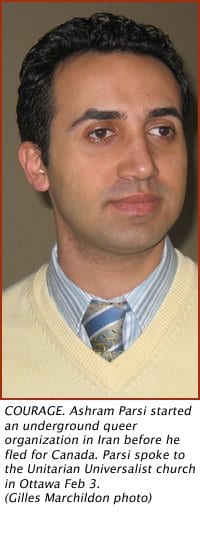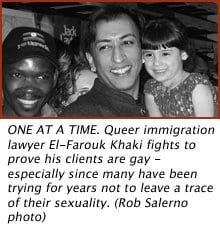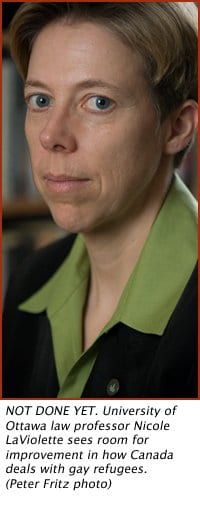Arsham Parsi was forced to leave his life behind. Threats loomed large. He spent years looking over his shoulder, carefully concealing the truth about himself from everyone he knew. Still, the dangers grew.
As a gay man in Iran — one who founded an underground organization to help queers — Parsi’s life was at risk. Under strict Iranian law, Parsi could have been hanged or publicly stoned, a particularly gruesome form of capital punishment in which his body would be battered by a jeering, angry crowd.
Facing this, he left his friends and family in 2005. He had no way of knowing if he would ever lay eyes on them again.
After making it to Turkey, he visited the office of the United Nations High Commissioner for Refugees. There he endured a seven-hour interview and a 10-hour session with a psychologist.
“That was so hard. Because you know, in that time I was so emotional, I cried for the whole interview,” says Parsi. “I left my family, my job, my friends, everything that I had. And I didn’t have anything, a few clothes and maybe $50 or $100. I didn’t have anything, just hope. I needed someone to talk to.”
The UN granted him a certificate of asylum. Later, he was referred to the Canadian Embassy and after eight months, he arrived in Canada.
“When I was in Iran, I was just silent. Not talking about everything. When I was at the UN, for the first day in my whole life, I told them who I am and what I do. Of course it was hard. In Iran, nobody knew I was working in that organization, called Rainbow Group. I used a nickname, and all of my friends only knew my nickname. I couldn’t trust anybody. That interview was the first day in my whole life where I could say I started this organization, and my name is Arsham.”
Refugees must battle their own fear of revealing to strangers what have always been hidden parts of their lives, and revealing such facts to a potentially unsympathetic government official can be a challenge all in itself.
Terror and relief. But for many gays and lesbians, relief is withheld, leaving them in legal limbo. The spectre of returning to their home country haunts them — sometimes for years — as they make their way through the cumbersome and sometimes homophobic process.
Toronto refugee lawyer El-Farouk Khaki recalls an incident in which one of his clients, seeking refugee status in Canada as a gay man, was told by a member of the Immigration and Refugee Board of Canada (IRB) that if he could be more discreet in his home country of Kenya, he would be just fine.
“What do you mean discreet? Are you telling him that for the rest of his life he has to look over his shoulder, and hope nobody finds out that he’s gay because if they do he could get jailed or mobbed and killed?” says Khaki. “Why should somebody have to hide their sexual orientation? You don’t have to hide your gender or your political opinion or your religion to avoid persecution.”
“There has to be a consistency of analysis. I should be able to wear my homosexuality on my sleeve if I choose to, and be safe. So there needs to be some ongoing sensitivity, particularly for IRB members who may not have openly queer people in their private lives and who are not familiar or sensitive to those issues.”
For all refugees, the process has several key steps. The claimant must apply at whichever point of entry into the country they first access, usually an airport or port or harbour. If the claim is being made after arriving in Canada, then the claimant goes to a Canada Immigration office. They get an appointment to come back, and they are given a personal information form to fill out.
Sound bureaucratic?
It’s on this form that they must tell their story, explaining why they fear persecution, in as much detail a possible. A hearing is scheduled, and the prospective refugee will be seen by a one-person panel, who will hear the claimant’s case and decide whether they fit the requirements to be deemed a refugee.
Canada’s guidelines for accepting refugees are based, as they are in most countries, on the United Nations’ 1951 Convention Relating to the Status of Refugees. The key passage in this document states that a refugee is a person who, “owing to well founded fear of being persecuted for reasons of race, religion, nationality, membership of a particular social group or political opinion, is outside the country of his nationality and is unable or, owing to such fear, is unwilling to avail himself of the protection of that country.”
For a majority of queer claimants, it is the “particular social group” clause under which they will make their claim.
And the burden of proof is on the queer refugee, according to Nicole LaViolette, an associate professor in the law department at the University of Ottawa.
They must prove they are gay — no small task for many who have spent years trying not to leave a trace of their gay identity. Then they must show that they fear persecution in their home country. Discrimination is not enough.
Khaki, who has practiced for 15 years, says that making each case for his clients is a unique challenge, since no two claimants’ situations are identical. He compares building the case for a refugee claim to a jigsaw puzzle, in which each piece must be turned over and carefully made to create a whole picture.
Khaki often turns to photos — perhaps of the claimant at Pride, or socializing in a gay bar — letters from friends or lovers, and even membership at bathhouses or online gay chatrooms. Each element helps to legitimize the claimant’s clear status as a gay person.
However, it is much more difficult to establish a claim when a person is less social, and therefore may have fewer opportunities to show that they are living and socializing as a gay person, he says.
He also points out that it can be more difficult for lesbians to make a refugee claim based on their sexual identity, since women tend to socialize differently than gay men.
“One of the most difficult parts is when somebody has been married, and has kids, and may still be married,” says Khaki. “A lot of my female clients actually, the harm that they fear is often more private than the harm that gay men fear, which is more public. Women often experience harm within the family within the context of the cultures; they may not have the same kind of access to public space as men do.”
“There might not be as many public spaces for women as there are for men. So a woman may not be able to demonstrate that she is living or socializing openly as a lesbian because she may not have opportunity, especially if she is a single parent. So, there is a gender perspective here as well.”
Many refugees arriving in Canada may also be unaware that they can even make a claim based on their sexuality. And they may not be eager to out themselves to a border official or IRB member, given that they may have experienced persecution or abuse from government officials in their country of origin.
But the laundry list of problems continues.
IRB hearings are conducted by a single board member, rather than two. That’s the result of the new Immigration and Refugee Protection Act, a 2002 law passed by the Crétien government.
Previously, there were two-member panels, and if there was a split decision, the case was more often than not found in favour of the claimant. Having two panel members served as a sort of check and balance against any possible biases or homophobic notions that might exist. With a single-member hearing, that check and balance is now gone.
The 2002 legislation also included a plan to institute a Refugee Appeal Division (RAD), through which claimants could appeal their case’s decision based on the merits. This served as a sort of carrot to the interested parties: a one-member panel would be acceptable if there would now be an appeal division to serve as a backup. However, the government held back the new division, and now, nearly six years later, it has still not been implemented.
With no RAD, and one-member panels, claimants who want their decision reconsidered have only one real next course of action: a federal judicial appeal. However, people who feel wronged can only make a claim based on legal mistakes, not on the factual merits of the case. As such, it does not really constitute a true appeal, according to both Khaki and LaViolette, who say that this is a serious flaw in the Canadian refugee system.
Danielle Norris, a media representative for Citizen and Immigration Canada (CIC), says there are several reasons why the appeal division has not yet been implemented.
“The in-Canada refugee determination system is often described as one of the best in the world. There’s no doubt that Canada meets its international commitments,” Norris says. “RAD is not necessary specifically at this time, as refugee claimants have access to three other mechanisms. Those are a judicial review, the second is a pre-removal risk-assessment at Citizen and Immigration Canada — and that ensures that no one is removed to risk or harm due to change in circumstances after their refugee claim decision. Third, there’s an opportunity to apply for permanent residence on compassionate grounds.”
The CIC’s website claims that the RAD was not implemented due to the high volume of refugee applications, and it was felt that implementing the RAD would add too much time to the processing of claims. It would also increase costs in provincial legal aid and social assistance budgets.
It is not clear how often refugees succeed in staying in Canada based on the three protective mechanisms that Norris cited, but critics say that they are not replacements for a formal appeal division. In fact, when Canada’s new legislation was enacted in 2002, The United Nations High Commission on Refugees issued a statement in which they expressed dismay at the fact that the RAD was scrapped.
“UNHCR has long urged Canada to introduce a review process — which is a vital part of determining refugee status — in its asylum procedure,” the statement reads in part. “We hope that the Refugee Appeal Division will be implemented in the near future. Canada is one of just a few industrialised countries that do not have an appeal on the merits in their refugee determination systems.”
There are encouraging signs. A private member’s bill would make the RAD a reality. Bill C-280, introduced by Bloc Quebecois MP Nicole Demers, is now at second reading. It obliges the feds to implement the promised but long-stalled review board.
But with no appeal division and one-member panels, a great deal of a claimant’s chance of being granted refugee status has to do with that single IRB member who hears their case. According to Khaki, this can cause serious problems if the board member is not “sophisticated” enough about queer issues.
“It depends on the sensitivity of the refugee board member. The reality is, I can take the same case in front of two different board members and get two different decisions. And that’s a sad thing, the apparent lack of consistency,” Khaki says.
Khaki feels it merits serious examination, since board members are making life-and-death decisions.
“There are members of the refugee board who are queer, or who have queer people in their private lives. But there are also board members who do not.”
However, the IRB does provide specific training to its members around issues pertaining to queer claimants, according to Stephane Malepart, who spoke on behalf of the Eastern Region Immigration and Refugee Board of Canada.
“Training happens on a regular basis,” says Malepart. “It specifically relates to sexual orientation. It makes Immigration and Refugee Board members aware, and it stresses the fact that it’s important for Board members to avoid relying on stereotypical perception of gay men and lesbians in determining their membership in a particular social group.”
“It also stresses that there is no uniform way in which lesbians and gay men recognize and act on their sexual orientation, so therefore answers to questions about a person’s sexual orientation may vary widely from one claimant to another. They also mention the fact that Board members have to keep in mind that sometimes it may be difficult for sexual minorities to speak about their sexual orientation, their lives,” Malepart says. He adds that the training also includes a section on how to appropriately question claimants about their personal relationships, their families, and what persecution they may have experienced or heard about in their country of origin.
According to LaViolette, Canada’s refugee system does work well for most refugees, and she says the IRB is a big part of that, though improvements still need to be continually made.
“They’re a fairly good quasi-judicial body. They’re certainly way ahead of the other countries when it comes to sexual minorities. But that’s not to say the system’s perfect.”



 Why you can trust Xtra
Why you can trust Xtra


